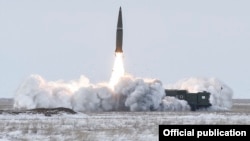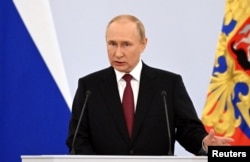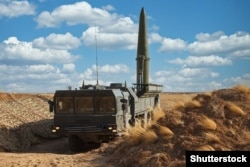The hint by Russian President Vladimir Putin wasn't exactly subtle.
"When the territorial integrity of our country is threatened, we will certainly use all the means at our disposal to protect Russia and our people," Putin said on September 21, as he announced an order to mobilize hundreds of thousands of men to fight in Ukraine. "This is not a bluff."
By "all means at our disposal," of course, Putin was referring to Russia's nuclear arsenal -- which, along with that of the United States, remains one of the two largest in the world by far more than 30 years after the end of the Cold War.
But the hint left a lot to interpretation, sending intelligence agencies from Washington to London to Berlin scrambling to discern what exactly he meant. U.S. officials have said repeatedly said -- most recently on October 10 -- that Russia has done nothing to cause U.S. or NATO officials to "adjust our posture," meaning order military forces on heightened alert.
Putin expanded on the comment nine days later when, during a Kremlin speech claiming sovereignty over four Ukrainian regions, he declared Russia would defend its territory "with all the forces and resources" it has, and then referred to the U.S. nuclear bombing of Japan in 1945 as a precedent.
There is little indication that Putin is prepared to attack Western capitals with long-range strategic missiles of the sort that would lead to outright thermonuclear war. But there are other possibilities, namely smaller, more portable, nonstrategic nuclear warheads known as tactical weapons.
In an interview with CNN on October 11, U.S. President Joe Biden chided Putin for his nuclear threats, though he inaccurately suggested Putin had explicitly threatened the use of a tactical weapon.
"He, in fact, cannot continue with impunity to talk about the use of a tactical nuclear weapon as if that's a rational thing to do," Biden said. "The mistakes get made. And the miscalculation could occur; no one can be sure what would happen and could end in Armageddon."
Here's what you need to know about tactical nuclear weapons.
Strategic Vs. Tactical
Most people are familiar with the terrifying Cold War-era imagery of intercontinental ballistic or cruise missiles: weapons launched from silos, submarines, and airplanes, or even heavy trucks in the case of Soviet and Russian forces, carrying single or multiple warheads that could rain down on dozens of locations, obliterating cities and populations, and possibly all life on Earth.
The New START treaty, in effect since 2011, is the most recent in a series of major arms control measures limiting the size and deployment of strategic weapons for Russia and the United States. According to the U.S. State Department, both Moscow and Washington have fewer than the maximum allowed number of deployed warheads: 1,550.
But New START limits only strategic nuclear weapons, not tactical nukes.
Also known as nonstrategic weapons, tactical nuclear arms are smaller -- both in size and explosive power -- designed for use in a battlefield or in a theater of operations, said Pavel Podvig, a longtime expert on Russia's nuclear arsenal who also works for the United Nations Institute for Disarmament Research in Geneva. Think of a bomb dropped from an airplane.
"The term is problematic because in reality any use of nuclear weapons will be strategic -- it will change (and the intent will be to change) the outcome of the conflict," Podvig said in an e-mail. "Even if they are used in the battlefield (which is unlikely to change anything there), the key message of such a step will be that Russia is prepared to use them more widely and eventually will be ready to use them against the population."
"Using the term 'tactical' can easily obscure that reality: that nuclear weapons get their power from their ability to kill a lot of people," he said.
Tactical weapons – bombs, artillery shells, short-range missiles – are designed to have less explosive firepower than the bigger strategic missiles. The explosive power or “yield” of a standard strategic nuclear weapon today can range roughly from 500 kilotons to 1 megaton, the equivalent of 1 million tons of TNT. Some nonstrategic nuclear weapons have yields of less than 1 kiloton, but others go as high as 50 kilotons – more than three times the force of the 15-kiloton bomb dropped on Hiroshima – or higher.
Many nonstrategic nuclear weapons can be rendered more or less explosive, something known as “dial-a-yield.”
These weapons are also smaller in size, and they're not designed to go long distances; if it's on a missile, it might not go more than 500 kilometers. That means they're harder for intelligence -- satellites, or powerful remote sensors, or even spies with binoculars -- to spot, which in turns means it's harder for an adversary to prepare or defend itself.
For that reason, many experts consider them more destabilizing and potentially more dangerous.
So, Who Has Them?
Both the United States and the Soviet Union developed small nuclear weapons in the darkest days of the Cold War arms race. The Soviet Union and its Warsaw Pact partners had many more tanks and infantry than NATO did, and use of tactical nuclear weapons was a key element -- called "flexible response" -- of NATO plans to stem a Warsaw Pact offensive on Western Europe.
Since then, however, the United States has moved away from reliance on tactical weapons, as military planners rely instead on more precise weaponry to accomplish the same goals: sophisticated conventional explosives that can pack as big a punch as a nuclear warhead.
Currently, the United States has around 200 tactical weapons deployed in Germany and other NATO allies, including Turkey. Half of these are the B61 nuclear gravity bomb, the sort you simply drop from a plane and then guide to a target.
Under President Donald Trump, U.S. officials called for developing new shorter-range, lower-yield nonstrategic weapons -- a sea-launched cruise missile, among other things -- but those plans are still in development.
Russia, meanwhile, is estimated to have around between 1,500 and 2,000 tactical warheads, including for things like gravity bombs, air-to-surface missiles, anti-ship missiles, cruise missiles, and even torpedoes. Most if not all of these warheads are in central storage, according to the Bulletin of Atomic Scientists.
In its war against Ukraine, Russia has also fired cruise missiles from submarines and aircraft, as well as using a short-range ballistic missile system known as the Iskander. The size of a tactical nuclear warhead placed atop an Iskander missile means the missile would be indistinguishable from one carrying a conventional warhead.
One other thing to remember, both for strategic and tactical weapons: A missile with a nuclear warhead attached, or a gravity bomb in a hangar that can be quickly put onto a plane, is considered a "deployed" warhead.
Both United States and Russia have stores of "nondeployed" warheads, mainly in storage; some are intended to be dismantled and destroyed. That means it would take time to get them out of storage and bring them a launch vehicle such as a plane, a truck, or a silo in order to be fired.
But how long that takes depends on lots of variables.
"None of these 'tactical' weapons…are deployed; they are not mated to their delivery systems," Podvig said. "So, they are in fact further away from being used -- it would take a number of steps to deploy them."
Have They Ever Been Used?
No tactical, nonstrategic nuclear weapon has ever been used in conflict.
Other Sabers To Rattle
In the past, Putin and other Russian officials -- not to mention pundits like firebrand TV host Dmitry Kiselyov -- have bragged about Russia's arsenal and some of the newer weapons the military is developing, like hypersonic missiles that could evade anti-missile defenses, or autonomous "drone" torpedoes.
In the Ukraine war, Putin hasn't explicitly threatened the use of tactical nuclear weapons or any specific weapon for that matter. That again leaves some room for how he would follow through on his threats, if he chooses to.
Aside from hitting Ukraine's forces with a tactical warhead, Russian forces could seek some sort of demonstration effect: Detonating a warhead over the Black Sea might not kill anyone but could be aimed to convince the West -- the United States, first and foremost -- that the Kremlin is prepared to use nuclear weapons to achieve its aims in Ukraine.
Or it could detonate a device in a more remote location, like Novaya Zemlya, the Barents Sea archipelago where Moscow has conducted nuclear testing for decades.
Or it could simply test one of its newer experimental weapons and make sure Western intelligence was readily able to witness the tests.
That could be, for example, a nuclear-powered cruise missile called the Burevestnik that has been under development for several years or an autonomous underwater drone capable of carrying a nuclear warhead, something critics have dubbed a "doomsday weapon."
What Effect Would A Tactical Nuclear Explosion Have?
That depends on what it is used for, where, and how.
Killing hundreds of Ukrainian troops on the battlefield with a nuclear weapon would cause outrage, different from the shock-and-awe effect of detonating a warhead over the Black Sea or the Barents Sea.
It's an open question whether the former would cow the Ukrainians into agreeing to peace negotiations. And it's a very open question whether the West would be compelled to pressure Kyiv to negotiate or dial back its support for Kyiv.
At the very least, it would break a taboo on using nuclear weapons, a taboo in place since the United States bombed Hiroshima and Nagasaki in 1945. It would also potentially isolate Russia from its lukewarm partners like China, a nuclear power in its own right.
"It must be understood that the use of a tactical nuclear weapon will not guarantee a turning point in one's favor at all," Andrei Kortunov, director of the government-linked Russian International Affairs Council, wrote in an opinion article published in the Russian daily Kommersant.
"What it will guarantee is the risk of a full-scale nuclear war, complete strategic solitude and [for Russia] the status of an international pariah," he wrote.













